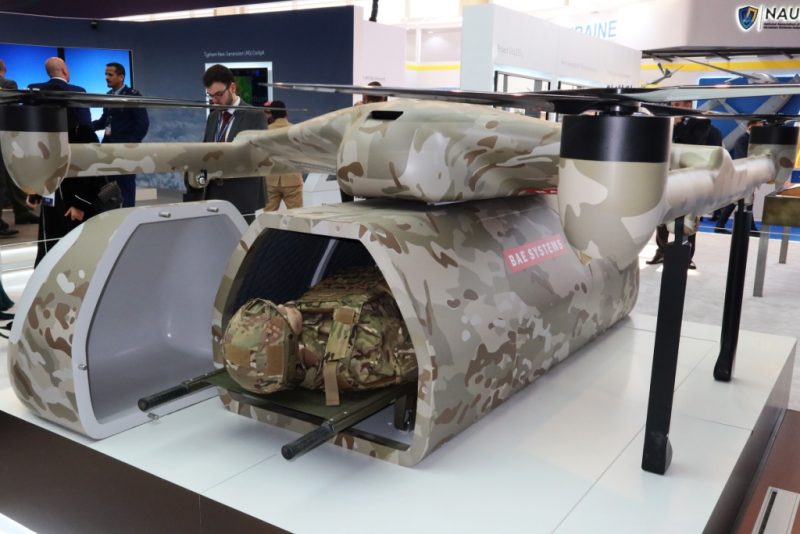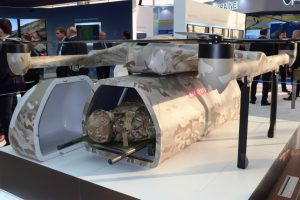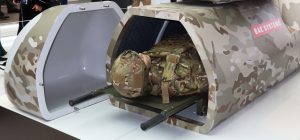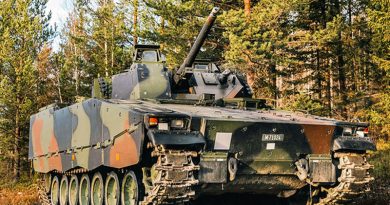WDS 2024 – BAE Systems showcases its T-650 heavy lift UAS in new CASEVAC role
Unveiled in fall 2021 and exhibited at the World Defense Show 2022 in the antisubmarine warfare configuration, carrying a Sting Ray lightweight torpedo, at this year edition of the Riyadh exhibition the BAE Systems T-650 concept was shown in the CASEVAC role, while smaller versions of this air vehicle have made their proof last year
In contested airspace as that existing on conventional battlefields, usually referred to with the A2/AD acronym for anti access area denial, the “Golden Hour” concept that was developed to ensure timely medical support to casualties in operations other than war is no more applicable, as French SF underlined in a roundtable last year. Mostly based on helicopter transport, risking a rotary wing asset in A2/AD bubbles would mean lose the chopper, its crew and let the casualty on the ground. Various solutions are being proposed, one being pushing forward medical treatment capacity. Unmanned VTOL airframes might however provide a capacity, allowing bringing towards medical facilities in the rear critical casualties.
A possible solution wash showcased at WDS by BAE Systems, based on its T-650 electric UAS. Still at concept phase study, the T-650 concept is however being de-risked using smaller size airframes such as the T-600 and before this the T-400. Developed and manufactured by Malloy Aeronautics, the T-400 quadcopter can transport a 400 lb (181 kg) payload and is being provided to Ukraine for first-line resupply missions. The T-650 programme was started by BAE Systems in cooperation with Malloy, the latter company having been acquired by BAE Systems just before the opening of WDS.
The T-400 bigger brother, the T-600, made its proof during REPMUS (Robotic Experimentation and Prototyping with Maritime Uncrewed Systems), a NATO exercise that took place in September 2023 along the coast of Portugal, during which it released an inert Sting Ray training variant anti-submarine torpedo during a flight mission at sea for the first time.
The electric-powered quadcopter demonstrator is being used for flight tests and aims at certification, which will be a key door-opener for the T-650. This will have a payload of nearly 300 kg, a maximum speed of 140 km/h and a range of 80 km without payload and 30 km with maximum payload.
The CASEVAC configuration exhibited at WDS saw a crashworthy transport pod, with an undisclosed degree of ballistic protection against small arms fire, environmentally protected and incorporating medical technology allowing stand off monitoring of vital signs. The pod has a mass of around 100 kg, to which we must add 10 kg for the stretcher (the pod is compatible with STANAG 2040 NATO stretcher), 100 kg for the average soldier and 30 kg of equipment, which keeps the grand total well under the 300 kg limit. The T-650 CASEVAC would land close to the medic attending the casualty; this will be inserted in the pod, the sensors will be put into place, the pod closed, a transparent allows the casualty to see outside reducing the claustrophobic effect, then the T-650 with its load would fly back where higher echelon medical support is available. This will happen at very low flight level, between 100 and 200 ft from the earth, thanks to terrain awareness sensors, navigation being provided by GPS/GNSS, SATCOM ensuring the data flow while landing sensors will allow automatic take-off and landing procedures.
Currently the T-650 is working on batteries, which justifies the relatively reduced range when loaded. However, BAE Systems sources confirmed to EDR On-Line that development studies are ongoing for a hybrid system based on a thermal engine and batteries, which would considerably increase the range. Beside the advantage of avoiding sending a human crew in a dangerous scenario, the T-650 will also reduce costs, as the cost-per-flight-hour estimate is three orders of magnitude lower compared to that of a medium helicopter.
BAE Systems is planning to have a prototype of the T-650 ready by late 2025, early 2026.
Photo by P. Valpolini





